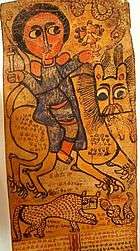Nine Saints
The Nine Saints were a group of missionaries who were important in the initial growth of Christianity in what is now Ethiopia during the late 5th century. Their names were Abba Aftse, Abba Alef, Abba Aragawi, Abba Garima (Isaac, or Yeshaq), Abba Guba, Abba Liqanos, Abba Pantelewon, Abba Sehma, and Abba Yem’ata. Although frequently described as coming from Syria, only two or three actually came from that province; according to Paul B. Henze, others have been traced to Constantinople, Anatolia, and even Rome.[1] The Ethiopian historian Tadesse Tamrat speculates that they may have been connected with the anti-Monophysite and anti-Miaphysite persecutions that followed the Council of Chalcedon, which adopted Dyophysitism. Their activities spread Christianity beyond "a narrow corridor between Adulis and Aksum along the caravan routes."[2] Besides converting the local inhabitants to Christianity, they also founded a number of monastic houses that followed the rule of Saint Pachomius: Abba Aftse founded the monastery at Yeha; Abba Alef the northernmost establishment at Bi'isa on the south bank of the Mareb River; the foundation of the important monastery of Debre Damo is attributed to Abba Aragawi; Abbas Liqanos and Pantelewon are credited with establishing Pentalewon Monastery in Axum; Abba Garima founded Abba Garima Monastery north of Adwa; Abba Guba the one at Madara; Abba Sehma one at Sedenya; and Abba Yem’ata founded the southernmost one of the group in the Gar'alta, noted for its Abuna Yemata Guh church named after him.[3]
| Part of a series on |
| Oriental Orthodoxy |
|---|
 |
| Oriental Orthodox churches |
|
Subdivisions
|
|
History and theology
|
|
Major figures
|
|
|
Abba Garima and the Garima Gospels
Recent radiocarbon dating supports the tradition of Saint Abba Garima's arrival at the Abba Garima Monastery in 494.[4] The Garima Gospels, which Garima is said to have written, is now regarded as "the world's earliest illustrated Christian manuscript" and the oldest surviving Ethiopian manuscript of any kind.[4]
Nine Saints in Cyprus
A painting belonging to the Cyprus Presidential Palace with the same title (but quite unrelated to the above) was on exhibition in the Λεβέντειος Πινακοθήκη in Nicosia in 2014. Information about the painting is found in the August 25th issue of the Greek-Cypriot Sunday newspaper Καθημερινή, .
The nine saints are also found in the Sinaxaristis (Συναξαριστής in Greek),
See also
References
- Paul B. Henze, Layers of Time: A History of Ethiopia (New York: Palgrave, 2000) p. 38.
- Taddesse Tamrat, Church and State in Ethiopia, 1270-1527 (Oxford: Clarendon Press, 1972 ISBN 0-19-821671-8), p. 23.
- This list is from Richard Pankhurst, The Ethiopians, A history (Oxford: Blackwell, 2001), p.37 n. 38
- Martin Bailey. "Discovery of earliest illuminated manuscript". "?". June 2010. Archived from the original on 2012-05-01.

